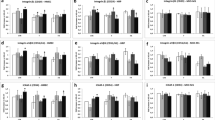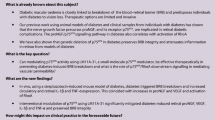Abstract
Aims
Diabetic retinopathy is considered a microvascular disease, but recent evidence has underlined early involvement of the neuroretina with interactions between microvascular and neural alterations. Topical administration of somatostatin (SST), a neuroprotective molecule with antiangiogenic properties, prevents diabetes-induced retinal neurodegeneration in animals. The α2-adrenergic receptor agonist brimonidine (BRM) decreases vitreoretinal vascular endothelial growth factor and inhibits blood–retinal barrier breakdown in diabetic rats. However, SST and BRM effects on microvascular cells have not yet been studied. We investigated the behaviour of these drugs on the crosstalk between microvasculature and neuroretina.
Methods
Expression of SST receptors 1–5 in human retinal pericytes (HRP) was checked. We subsequently evaluated the effects of diabetic-like conditions (high glucose and/or hypoxia) with/without SST/BRM on HRP survival. Endothelial cells (EC) and photoreceptors were maintained in the above conditions and their conditioned media (CM) used to culture HRP. Vice versa, HRP-CM was used on EC and photoreceptors. Survival parameters were assessed.
Results
HRP express the SST receptor 1 (SSTR1). Glucose fluctuations mimicking those occurring in diabetic subjects are more damaging for pericytes and photoreceptors than stable high glucose and hypoxic conditions. SST/BRM added to HRP in diabetic-like conditions decrease EC apoptosis. However, neither SST nor BRM changed the response of pericytes and neuroretina–vascular crosstalk under diabetic-like conditions.
Conclusions
Retinal pericytes express SSTR1, indicating that they can be a target for SST. Exposure to SST/BRM had no adverse effects, direct or mediated by the neuroretina, suggesting that these molecules could be safely evaluated for the treatment of ocular diseases.




Similar content being viewed by others
Abbreviations
- BRB:
-
Blood–retinal barrier
- BRM:
-
Brimonidine
- DMO:
-
Diabetic macula oedema
- DR:
-
Diabetic retinopathy
- EC:
-
Endothelial cells
- HG:
-
High glucose concentrations
- HMEC:
-
Human microvascular endothelial cells
- Hypo:
-
Hypoxic conditions
- intHG:
-
Intermittent high glucose concentrations
- NG:
-
Physiological glucose concentrations
- NMDA:
-
N-Methyl-d-aspartate
- PDR:
-
Proliferative diabetic retinopathy
- RT-PCR:
-
Real-time PCR
- SST:
-
Somatostatin
- SSTR:
-
Somatostatin receptor(s)
- VEGF:
-
Vascular endothelial growth factor
References
Gerhardt H, Betsholtz C (2003) Endothelial-pericyte interactions in angiogenesis. Cell Tissue Res 314:15–23
Armulik A, Abramsson A, Betsholtz C (2005) Endothelial/pericyte interactions. Circ Res 97:512–523
Barber AJ (2003) A new view of diabetic retinopathy: a neurodegenerative disease of the eye. Prog Neuropsychopharmacol Biol Psychiatry 27:283–290
Antonetti DA, Barber AJ, Bronson SK et al (2006) JDRF Diabetic retinopathy center group. Diabetic retinopathy: seeing beyond glucose-induced microvascular disease. Diabetes 55:2401–2411
Hernández C, García-Ramírez M, Corraliza L, Fernández-Carneado J, Farrera-Sinfreu Ponsati B, González-Rodríguez A, Valverde AM, Simó R (2013) Topical administration of somatostatin prevents retinal neurodegeneration in experimental diabetes. Diabetes 62:2569–2578
Carrasco E, Hernández C, Miralles A, Huguet P, Farrés J, Simó R (2007) Lower somatostatin expression is an early event in diabetic retinopathy and is associated with retinal neurodegeneration. Diabetes Care 30:2902–2908
Ng YK, Zeng XX, Ling EA (2004) Expression of glutamate receptors and calcium binding proteins in the retina of streptozotocin-induced diabetic rats. Brain Res 1018:66–72
Silva KC, Rosales MA, Biswas SK, Lopes de Faria JB, Lopes de Faria JM (2009) Diabetic retinal neurodegeneration is associated with mitochondrial oxidative stress and is improved by an angiotensin receptor blocker in a model combining hypertension and diabetes. Diabetes 58:1382–1390
Nishikawa T, Edelstein D, Brownlee M (2000) The missing link: a single unifying mechanism for diabetic complications. Kidney Int 58:S26–S30
Berner AK, Brouwers O, Pringle R et al (2012) Protection against methylglyoxal derived AGEs by regulation of glyoxalase 1 prevents retinal neuroglial and vasodegenerative pathology. Diabetologia 55:845–854
Downie LE, Pianta MJ, Vingrys AJ, Wilkinson-Berka JL, Fletcher EL (2008) AT1 receptor inhibition prevents astrocyte degeneration and restores vascular growth in oxygen-induced retinopathy. Glia 56:1076–1090
Marin Garcia PJ, Marin-Castaño ME (2014) Angiotensin II-related hypertension and eye diseases. World J Cardiol 6:968–984. doi:10.4330/wjc.v6.i9.968
Raza A, Franklin MJ, Dudek AZ (2010) Pericytes and vessel maturation during tumor angiogenesis and metastasis. Am J Hematol 85:593–598
Hernández C, Carrasco E, Casamitjana R, Deulofeu R, García-Arumí J, Simó R (2005) Somatostatin molecular variants in the vitreous fluid: a comparative study between diabetic patients with proliferative diabetic retinopathy and nondiabetic control subjects. Diabetes Care 28:1941–1947
Simó R, Carrasco E, García-Ramírez M, Hernández C (2006) Angiogenic and antiangiogenic factors in proliferative diabetic retinopathy. Curr Diabetes Rev 2:71–98
Cervia D, Casini G, Bagnoli P (2008) Physiology and pathology of somatostatin in the mammalian retina: a current view. Mol Cell Endocrinol 286:112–122
Kiagiadaki F, Savvaki M, Thermos K (2010) Activation of somatostatin receptor (SST 5) protects the rat retina from AMPA-induced neurotoxicity. Neuropharmacology 58:297–303
Baptiste DC, Hartwick AT, Jollimore CA et al (2002) Comparison of the neuroprotective effects of adrenoceptor drugs in retinal cell culture and intact retina. Invest Ophthalmol Vis Sci 43:2666–2676
Mayor-Torroglosa S, De la Villa P, Rodríguez ME et al (2005) Ischemia results 3 months later in altered ERG, degeneration of inner layers, and deafferented tectum: neuroprotection with brimonidine. Invest Ophthalmol Vis Sci 46:3825–3835
Kusari J, Zhou SX, Padillo E, Clarke KG, Gil DW (2010) Inhibition of vitreoretinal VEGF elevation and blood-retinal barrier breakdown in streptozotocin-induced diabetic rats by brimonidine. Invest Ophthalmol Vis Sci 51:1044–1051. doi:10.1167/iovs.08-3293
Beltramo E, Berrone E, Tarallo S, Porta M (2009) Different apoptotic responses of human and bovine pericytes to fluctuating glucose levels and protective role of thiamine. Diabetes Metab Res Rev 25:566–576. doi:10.1002/dmrr.996
van Hagen PM, Baarsma GS, Mooy CM, Ercoskan EM, ter Averst E, Hofland LJ, Lamberts SW, Kuijpers RW (2000) Somatostatin and somatostatin receptors in retinal diseases. Eur J Endocrinol 143(Suppl 1):S43–S51
Klisovic DD, O’Dorisio MS, Katz SE, Sall JW, Balster D, O’Dorisio TM, Craig E, Lubow M (2001) Somatostatin receptor gene expression in human ocular tissues: RT-PCR and immunohistochemical study. Invest Ophthalmol Vis Sci 42:2193–2201
Adams RL, Adams IP, Lindow SW, Zhong W, Atkin SL (2005) Somatostatin receptors 2 and 5 are preferentially expressed in proliferating endothelium. Br J Cancer 92:1493–1498
Beltramo E, Nizheradze K, Berrone E, Tarallo S, Porta M (2009) Thiamine and benfotiamine prevent apoptosis induced by high glucose-conditioned extracellular matrix in human retinal pericytes. Diabetes Metab Res Rev 25:647–656. doi:10.1002/dmrr.1008
Simó R, Hernández C, European Consortium for the Early Treatment of Diabetic Retinopathy (EUROCONDOR) (2014) Neurodegeneration in the diabetic eye: new insights and therapeutic perspectives. Trends Endocrinol Metab 25:23–33
Thermos K, Bagnoli P, Epelbaum J, Hoyer D (2006) The somatostatin sst1 receptor: an autoreceptor for somatostatin in brain and retina? Pharmacol Ther 110:455–464
Casini G, Dal Monte M, Petrucci C, Gambellini G, Grouselle D, Allen JP, Kreienkamp HJ, Richter D, Epelbaum J, Bagnoli P (2004) Altered morphology of rod bipolar cell axonal terminals in the retinas of mice carrying genetic deletion of somatostatin subtype receptor 1 or 2. Eur J Neurosci 19:43–54
Dal Monte M, Latina V, Cupisti E, Bagnoli P (2012) Protective role of somatostatin receptor 2 against retinal degeneration in response to hypoxia. Naunyn Schmiedebergs Arch Pharmacol 385:481–494. doi:10.1007/s00210-012-0735-1
Beltramo E, Porta M (2013) Pericyte loss in diabetic retinopathy: mechanisms and consequences. Curr Med Chem 20:3218–3225
Aplin AC, Nicosia RF (2016) Hypoxia paradoxically inhibits the angiogenic response of isolated vessel explants while inducing overexpression of vascular endothelial growth factor. Angiogenesis 19:133–146. doi:10.1007/s10456-015-9493-2
Shweiki D, Itin A, Soffer D, Keshet E (1992) Vascular endothelial growth factor induced by hypoxia may mediate hypoxia-initiated angiogenesis. Nature 359(6398):843–845
Ferjoux G, Bousquet C, Cordelier P, Benali N, Lopez F, Rochaix P, Buscail L, Susini C (2000) Signal transduction of somatostatin receptors negatively controlling cell proliferation. J Physiol Paris 94:205–210
Duran-Prado M, Morell M, Delgado-Maroto V, Castaño JP, Aneiros-Fernandez J, de Lecea L, Culler MD, Hernandez-Cortes P, O’Valle F, Delgado M (2013) Cortistatin inhibits migration and proliferation of human vascular smooth muscle cells and decreases neointimal formation on carotid artery ligation. Circ Res 112:1444–1455
Aoki T, Motoi F, Sakata N, Naitoh T, Katayose Y, Egawa S, Miyazaki J, Unno M (2014) Somatostatin analog inhibits the growth of insulinoma cells by p27-mediated G1 cell cycle arrest. Pancreas 43:720–729. doi:10.1097/MPA.0000000000000128
Sharma K, Srikant CB (1998) Induction of wild-type p53, Bax, and acidic endonuclease during somatostatin-signaled apoptosis in MCF-7 human breast cancer cells. Int J Cancer 76:259–266
Tarallo S, Beltramo E, Berrone E, Porta M (2012) Human pericyte-endothelial cell interactions in co-culture models mimicking the diabetic retinal microvascular environment. Acta Diabetol 49(Suppl 1):S141–S151. doi:10.1007/s00592-012-0390-5
Beltramo E, Lopatina T, Berrone E, Mazzeo A, Iavello A, Camussi G, Porta M (2014) Extracellular vesicles derived from mesenchymal stem cells induce features of diabetic retinopathy in vitro. Acta Diabetol 51:1055–1064. doi:10.1007/s00592-014-0672-1
Mazzeo A, Beltramo E, Iavello A, Carpanetto A, Porta M (2015) Molecular mechanisms of extracellular vesicle-induced vessel destabilization in diabetic retinopathy. Acta Diabetol 52:1113–1119. doi:10.1007/s00592-015-0798-9
Elfont RM, Sundaresan PR, Sladek CD (1989) Adrenergic receptors on cerebral microvessels: pericyte contribution. Am J Physiol 256(1 Pt 2):R224–R230
Ferrari-Dileo G, Davis EB, Anderson DR (1992) Effects of cholinergic and adrenergic agonists on adenylate cyclase activity of retinal microvascular pericytes in culture. Invest Ophthalmol Vis Sci 33:42–47
Montiel-Eulefi E, Nery AA, Rodrigues LC, Sánchez R, Romero F, Ulrich H (2012) Neural differentiation of rat aorta pericyte cells. Cytometry A 81:65–71. doi:10.1002/cyto.a.21152
Wanek J, Blair NP, Chau FY, Lim JI, Leiderman YI, Shahidi M (2016) Alterations in retinal layer thickness and reflectance at different stages of diabetic retinopathy by en face optical coherence tomography. Invest Ophthalmol Vis Sci 57:341–347. doi:10.1167/iovs.15-18715
Mollick T, Mohlin C, Johansson K (2016) Human neural progenitor cells decrease photoreceptor degeneration, normalize opsin distribution and support synapse structure in cultured porcine retina. Brain Res. doi:10.1016/j.brainres.2016.06.039 [Epub ahead of print]
Scarinci F, Nesper PL, Fawzi AA (2016) Deep retinal capillary nonperfusion is associated with photoreceptor disruption in diabetic macular ischemia. Am J Ophthalmol 168:129–138. doi:10.1016/j.ajo.2016.05.002
Acknowledgments
This research was supported by the EUROCONDOR project, Grant Agreement Number 278040, funded by the European Commission’s Seventh Framework Programme (theme FP7-HEALTH-2011.2.4.3-1). This publication reflects the views only of the Authors, and the European Commission cannot be held responsible for any use which may be made of the information contained therein.
Author information
Authors and Affiliations
Corresponding author
Ethics declarations
Conflict of interest
Elena Beltramo, Tatiana Lopatina, Aurora Mazzeo, Ana I Arroba, Angela M Valverde, Cristina Hernández, Rafael Simó and Massimo Porta declare that they have no conflicts of interest.
Human and animal rights
This article does not contain any studies with human or animal subjects performed by the any of the authors.
Informed consent
For this type of study formal consent is not required.
Additional information
Managed by Massimo Federici.
Rights and permissions
About this article
Cite this article
Beltramo, E., Lopatina, T., Mazzeo, A. et al. Effects of the neuroprotective drugs somatostatin and brimonidine on retinal cell models of diabetic retinopathy. Acta Diabetol 53, 957–964 (2016). https://doi.org/10.1007/s00592-016-0895-4
Received:
Accepted:
Published:
Issue Date:
DOI: https://doi.org/10.1007/s00592-016-0895-4




